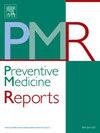Changes in pediatric obesity rates before and during the COVID pandemic in a Federally Qualified Health Center
IF 2.4
3区 医学
Q2 PUBLIC, ENVIRONMENTAL & OCCUPATIONAL HEALTH
引用次数: 0
Abstract
Objectives
The changes with pediatric obesity rates during the COVID pandemic with patients from Federally Qualified Health Center (FQHC) clinics are underrepresented in the literature. FQHC patients are often subject to many adverse social determinants of health (SDOH). We sought to characterize changes in obesity rates and weight categories amongst children at a FQHC, comparing a COVID pandemic cohort to a pre-pandemic cohort.
Methods
FQHC retrospective clinic data were analyzed for two separate cohorts of children aged 4 to 5 years: Pre-pandemic (2016–2019) and Pandemic (2019–2022). BMI values, BMI percentiles, and obesity rates were compared. Changes between weight categories for individual children were compared. Study participant SDOH related data was obtained from the electronic records, including individual zip codes. Aggregate study entry obesity rates for both cohorts were significantly greater than the national obesity rate.
Results
During each cohort's three-year period, BMI values increased significantly. There was no significant difference between the cohorts in these changes. Analysis of individual children's changes in weight categories revealed that significantly more children in the pandemic cohort demonstrated shifts between obese and other weight categories compared to the pre-pandemic cohort during comparable 3-year study periods.
Conclusions
This study is one of the first to investigate the details related to the changes with weight categories with a FQHC pandemic cohort. We suggest that these patterns warrant further study into the complex interactions of health inequities that are related to race and social determinants of health, aggravated by public health crises such as the COVID pandemic.
联邦合格医疗中心在COVID大流行之前和期间儿童肥胖率的变化
目的:在联邦合格卫生中心(FQHC)诊所就诊的患者在COVID大流行期间儿童肥胖率的变化在文献中未被充分代表。FQHC患者往往受到许多不利的健康社会决定因素(SDOH)的影响。我们试图描述FQHC中儿童肥胖率和体重类别的变化,并将COVID大流行队列与大流行前队列进行比较。方法sfqhc回顾性临床数据分析了两个独立的4至5岁儿童队列:大流行前(2016-2019)和大流行(2019-2022)。比较BMI值、BMI百分位数和肥胖率。比较了个别儿童体重类别之间的变化。研究参与者的SDOH相关数据从电子记录中获得,包括个人邮政编码。两组人群的总体入组肥胖率均显著高于全国肥胖率。结果在每个队列的三年期间,BMI值显著增加。这些变化在队列之间没有显著差异。对个别儿童体重类别变化的分析显示,在可比较的3年研究期间,与大流行前队列相比,大流行队列中有更多儿童表现出肥胖和其他体重类别之间的转变。本研究是首次研究FQHC大流行队列中体重类别变化相关细节的研究之一。我们认为,这些模式值得进一步研究与种族和健康的社会决定因素相关的卫生不平等之间的复杂相互作用,并因COVID大流行等公共卫生危机而加剧。
本文章由计算机程序翻译,如有差异,请以英文原文为准。
求助全文
约1分钟内获得全文
求助全文
来源期刊

Preventive Medicine Reports
Medicine-Public Health, Environmental and Occupational Health
CiteScore
3.90
自引率
0.00%
发文量
353
 求助内容:
求助内容: 应助结果提醒方式:
应助结果提醒方式:


